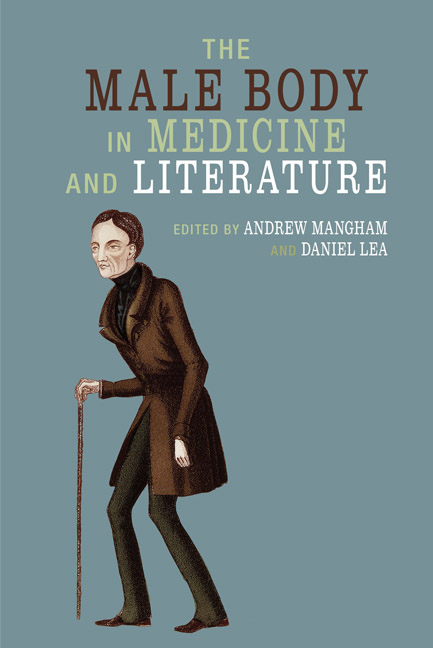Book contents
- Frontmatter
- Contents
- Acknowledgements
- Notes on Contributors
- Introduction
- Part One Enquiry and Experimentation
- Part Two Wounded and Psychopathologised Bodies
- Part Three Fear, Confusion and Contagion
- 9 ‘Sons of Belial’: Contaminated/Contaminating Victorian Male Bodies
- 10 Syphilis and Sociability: The Impolite Bodies of Two Gentlemen, James Boswell (1740–1795) and Sylas Neville (1741–1840)
- 11 ‘’Tis My Father's Fault’: Tristram Shandy and Paternal Imagination
- 12 Southern Gothic and the Queer Male Body
- Index
9 - ‘Sons of Belial’: Contaminated/Contaminating Victorian Male Bodies
from Part Three - Fear, Confusion and Contagion
- Frontmatter
- Contents
- Acknowledgements
- Notes on Contributors
- Introduction
- Part One Enquiry and Experimentation
- Part Two Wounded and Psychopathologised Bodies
- Part Three Fear, Confusion and Contagion
- 9 ‘Sons of Belial’: Contaminated/Contaminating Victorian Male Bodies
- 10 Syphilis and Sociability: The Impolite Bodies of Two Gentlemen, James Boswell (1740–1795) and Sylas Neville (1741–1840)
- 11 ‘’Tis My Father's Fault’: Tristram Shandy and Paternal Imagination
- 12 Southern Gothic and the Queer Male Body
- Index
Summary
There is a long tradition of female bodies being positioned as dangerous and contaminating. However, men's bodies have not necessarily been seen as the pure, healthy, wholesome and unproblematic counterpart. While much work has been done on Victorian attitudes to women and their bodies, this chapter examines the less-studied topic of attitudes of Victorian men to their specifically gendered sexual male bodies.
Although the male body and its urges was increasingly problematised by the rising social purity movement and a female-centred advocacy of a single moral standard by the later decades of the nineteenth century, this new discourse had deep roots in pre-existing fears and anxieties and, indeed, a sense of disgust around the male body and its sexual functioning.
Rob Boddice has made an elegant case that the notion that the white, Victorian, middle-class male's mind represented the apogee of evolution bore within it the seeds of its own extreme instability. Ina Zweiniger-Bargielowska has delineated the anxieties about the impact of modern urban life on the male body and concerns about its flabbiness, unfitness and degeneracy even before the revelations of the high rejection rate of recruits for the Boer War.
It is far from the case that men's bodies have necessarily been seen as pure, healthy, wholesome and unproblematic. Certainly in the nineteenth century there was – and this appears to have increased over the course of the decades – a sense that there was something deeply problematic about male sexual bodies. This was not merely the persistent individual male concern about impotence, which can be discovered throughout history in many different cultures, as Angus McLaren has revealed in his monumental study of the topic, although that was certainly present. There was a feeling that male bodies were dangerous and potentially both contaminated and contaminating in their own right. Most discussion of Victorian sexual fears and fantasies has focused on the female body, but within that general climate it was hardly possible for men to be unaffected by these pervasive anxieties.
Over the past decade or so a number of important and influential studies of male/male sex in Victorian Britain, by Charles Upchurch, Harry Cocks, Morris Kaplan, Sean Brady and Matt Cook, have delineated the state of the law and its practice, plus social attitudes, and the experiences of men who identified themselves as ‘inverted’.
- Type
- Chapter
- Information
- The Male Body in Medicine and Literature , pp. 159 - 176Publisher: Liverpool University PressPrint publication year: 2018



